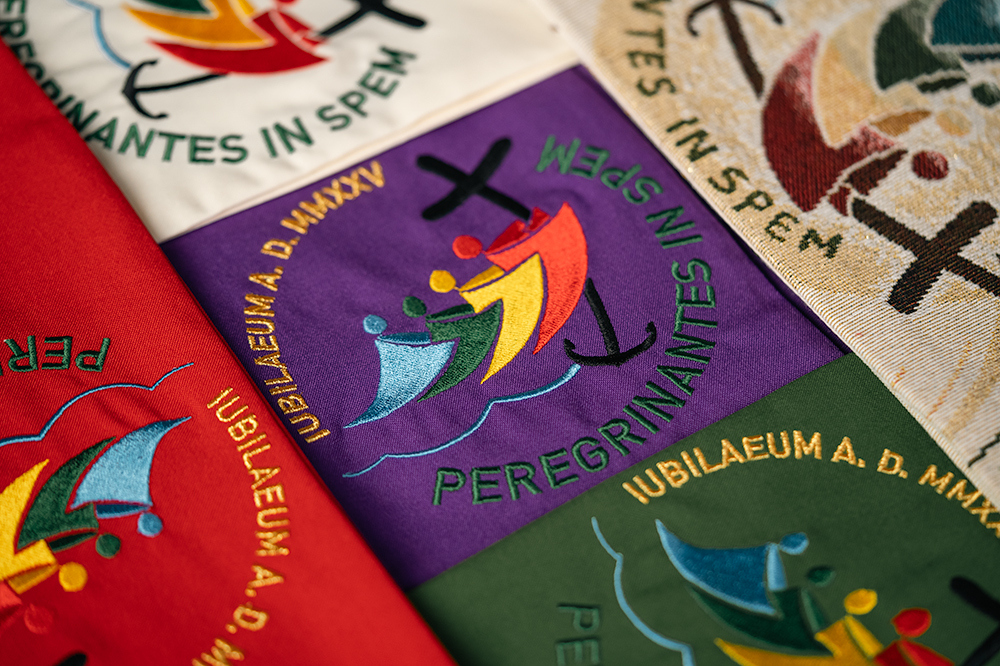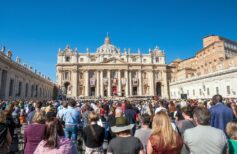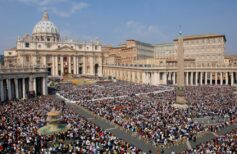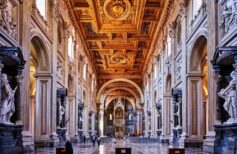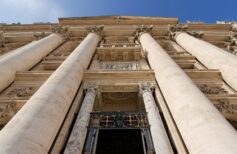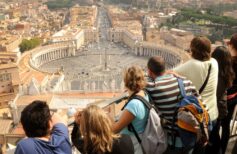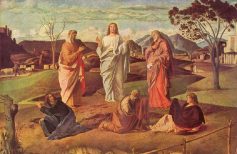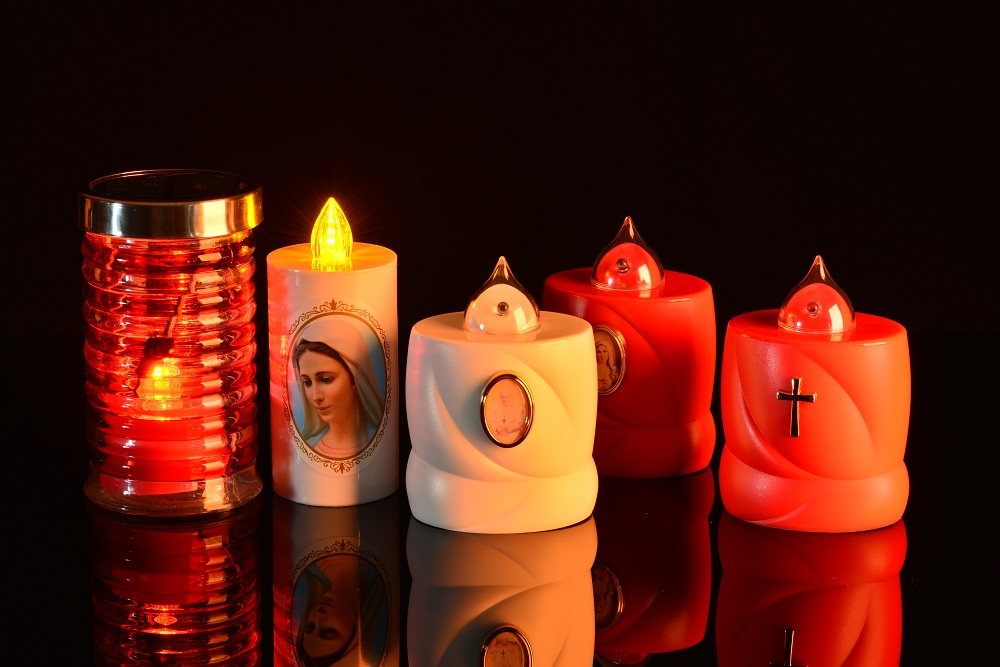The logo of the Jubilee 2025 has been unveiled, chosen from nearly three hundred proposals. A symbol of hope and fraternity that will guide us in the faith pilgrimage of the Holy Year.
As preparations for the Holy Year 2025 are underway, with the rich calendar being made public and the hymn being performed for the first time, the logo of the Jubilee is also beginning to spread. It is an image rich in symbolism, representing the central themes of the Holy Year: hope, mercy, and fraternity.
The logo was presented last June 28th during the press conference held in the Regia Hall of the Apostolic Palace in Vatican City, in the presence of Monsignor Rino Fisichella, pro-prefect of the Dicastery for Evangelization, and was well received by bishops, priests, and laypeople.
Indeed, it is a simple and universal image, understandable by people of all cultures and religions, and it encapsulates an invitation for all to walk together towards a better future, guided by faith and the will to build a better world marked by mercy and fraternity. This hope is underscored by the motto of the Jubilee 2025, prominently displayed in green at the bottom of the logo: “Peregrinantes in Spem,” “Pilgrims in Hope.”
Because hope will be the guiding thread of the Holy Year 2025.
But let’s see in detail what the Jubilee logo represents and what its significance is.
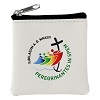
Jubilee 2025 in Rome
Jubilee Logo: Meaning
The logo chosen for the Holy Year depicts four stylized and graceful figures, in four colours that recall the shades of the rainbow: red, orange, green, and blue. The choice of colours is not random, just as the colour of sacred vestments throughout the liturgical year is not. Red symbolizes love, passion, and self-sacrifice, Christ’s sacrifice and His boundless love for humanity, but also the fire of the Holy Spirit and His strength that animates Christians. Orange expresses joy, vitality, and enthusiasm, the light that illuminates the path of faith. Green is universally recognized as the colour of hope, growth, and rebirth. Blue, finally, symbolizes faith, peace, and tranquillity, evoking the sky and spirituality, and inviting contemplation and prayer.
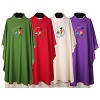
red, purple, green and ivory.
The four figures represent humanity as a whole, in its differences and similarities. They proceed to embrace each other, expressing the solidarity and brotherhood that should unite the peoples of the world. Leading them is the red figure, clinging to a Cross formed by a black curve that ends, at the bottom, with an anchor. The Cross is not rigid, not static, but bends towards humanity as if to embrace it. As for the anchor, Monsignor Fisichella himself explained its meaning: “As is known, the anchor has often been used as a metaphor for hope. The anchor of hope is the name given in seafaring jargon to the reserve anchor, used by vessels to perform emergency manoeuvres to stabilize the ship during storms.” The sense of this symbol in the Jubilee logo is clear: it is precisely in the most difficult moments that we need to rely on an anchor that gives us security and guarantees salvation, and what better anchor than the Cross, a symbol of Christ and His infinite love for all of us? The presence of small agitated waves at the bottom of the logo confirms the existence of dangers and obstacles, of those personal events and events of the world that make each of our lives not always easy.
Thus, the logo in its entirety takes on a clear meaning, and the Jubilee, with its twelve months of ceremonies and initiatives, becomes a long pilgrimage to be undertaken together, as brothers, towards salvation, guided by the Cross and the hope of salvation promised by God.

5 places of pilgrimage to go to at least once in a lifetime
God’s action on this Earth leaves a strong mark that attracts us: here are five pilgrimages of faith to be made at least once in a lifetime.
Theme: Pilgrims of Hope
The theme of the Jubilee in Rome is all encapsulated in the aforementioned motto: “Pilgrims in Hope.” Speaking of the theme chosen for the upcoming Jubilee, Pope Francis emphasized the importance of a deeper spiritual reflection on Mercy, encouraging prayer and a higher awareness of the divine will in our daily lives, through concrete actions of compassion, forgiveness, and solidarity. Furthermore, the Pope recommended that everyone dedicate 2024 to prayer, in preparation for the Jubilee, meditating on the mercy of God the Father and our role as witnesses and active promoters of mercy in the modern world.
This motto sounds like an invitation to walk together, addressed to all Christians and men, to proceed united towards a better future, based on hope, mercy, and fraternity, a continuous journey in search of God and His salvation. The very idea of pilgrimage suggests the communal dimension of the Church: we are all on this journey together, no one is alone in their quest for salvation, in their desire to reconcile with God and neighbour. Indeed, the pilgrimage is an opportunity to witness the joy of the Gospel, share one’s faith with the world, and build a future of peace and fraternity for all.

Pilgrimage to Rome: Among Christians’ Preferred Destinations
A pilgrimage to Rome has always been one of the most significant spiritual experiences for Christians from around the world.
Author of the Jubilee 2025 logo
To choose the logo, an international competition was announced, with 294 participants from 48 different countries. The competition was not only aimed at graphic designers but at anyone who wanted to contribute by presenting their proposal. There were also many hand-drawn designs by children, and the age range of the participants ranged from 6 to 83 years. In the end, the three projects that reached the final selection were submitted to Pope Francis, for him to choose the one he deemed most suitable.
The winner was Giacomo Trevisani, a young graphic designer from Puglia, who explained his graphic choice and the study behind the creation of the logo with these words: “I imagined people of every colour moving from every part of the earth towards a common future, and towards a Cross that is Jesus himself. I imagined the Pope leading humanity through a Cross that becomes an anchor, and us clinging to him, symbolizing pilgrims of all time.”
An appropriate standard is to guide Christians from all over the world and humanity as a whole through this year of jubilant events and global initiatives, to try to make our world a better place for future generations, enlightened by hope and reassured by the love and promise of God.

